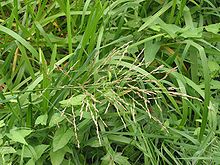Glyceria maxima
| Glyceria maxima | |
|---|---|

| |
| Scientific classification | |
| Kingdom: | Plantae |
| Clade: | Tracheophytes |
| Clade: | Angiosperms |
| Clade: | Monocots |
| Clade: | Commelinids |
| Order: | Poales |
| Family: | Poaceae |
| Subfamily: | Pooideae |
| Genus: | Glyceria |
| Species: | G. maxima |
| Binomial name | |
| Glyceria maxima | |
Glyceria maxima (syn. G. aquatica (L.) Wahlenb.; G. spectabilis Mert. & W.D.J. Koch; Molinia maxima Hartm.; Poa aquatica L.), imfe Nd[1][2] commonly known as great manna grass, reed mannagrass, reed sweet-grass,[3] and greater sweet-grass[4] is a species of rhizomatous perennial grasses in the mannagrass genus native to Europe and Western Siberia and growing in wet areas such as riverbanks and ponds. It is highly competitive and invasive and is often considered to be a noxious weed outside its native range.
References
- ^ Shaw, W (1828). Diary. 28 Feb.We found a number of the men assembled at one of the Kraals, chewing Imfay, or sweet cane.
- ^ Munday, J. (1987). Grasses, Grains & Conservation 14Two kinds of sugar cane, umoba and imphe, were grown in Natal by the indigenous people long before the arrival of the white man in 1823.
- ^ BSBI List 2007 (xls). Botanical Society of Britain and Ireland. Archived from the original (xls) on 2015-06-26. Retrieved 2014-10-17.
- ^ "Papercourt citation" (PDF). Sites of Special Scientific Interest. Natural England. Retrieved 15 November 2018.
External links
- USDA PLANTS Profile
- Glyceria maxima in Flora of China
